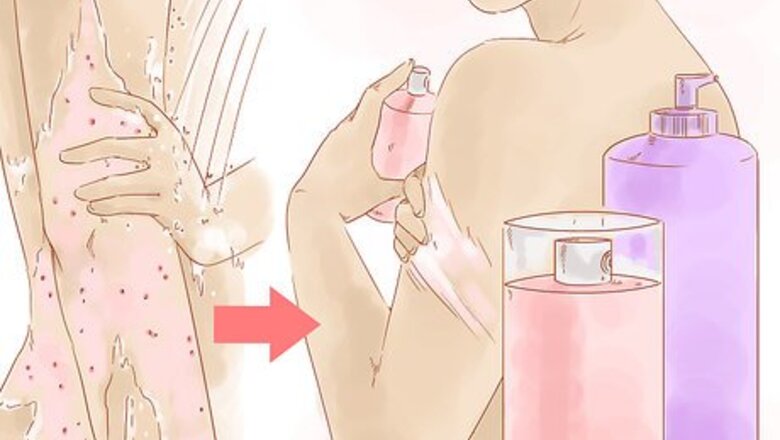
views
Home Remedies
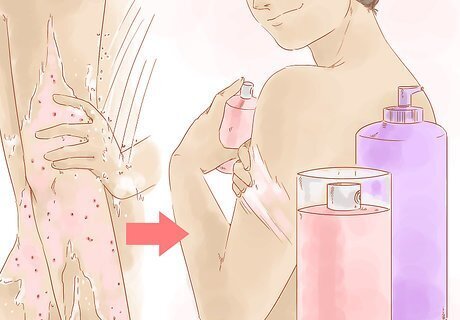
Exfoliate your skin twice a week. Use a gentle chemical exfoliant, such as a product with salicylic acid, glycolic acid, or hyaluronic acid no more than 2-3 times a week. Exfoliating helps remove dead skin cells and lets your skincare products absorb better into your skin, helping to minimize wrinkles. Over-exfoliating, though, can have damaging effects. Avoid mechanical exfoliation products such as scrubs. These can be harsh on the delicate areas of your face and cause microabrasions. Always follow your exfoliator directly with a moisturizer. It will typically take at least 3-4 weeks to notice benefits from exfoliation.

Train your forehead muscles. You might have more difficulties with forehead wrinkles if you use your forehead muscles to open your eyes instead of relying on your eyelids. Performing a simple exercise to train these muscles may help reduce the creases in your forehead while also correcting droopy eyelids. Curl your hands into "C" shapes and place them directly over your eyes. The index fingers should be positioned above each eyebrow, along the upper bone of your eye cavity, and the thumbs should be placed on either side of the nose, just above the nostril. Press the fingers of each hand downward and sideways, then open your chest and roll down your shoulder blades. Open your eyes as wide as possible and hold the position for five seconds. During this time, press your index fingers into your eyebrows to prevent the brows and forehead from moving. Squint the eyes five times, then close your eyes completely and relax for five seconds. Repeat the entire process two more times, and repeat the exercise at least once daily until you notice results.

Use topical wrinkle creams. Topical retinol and retinoids are among the most prevalent anti-aging creams on the market, and they can help reduce the appearance of wrinkles. Moisturizers that contain peptides also work well. Topical creams like these are specifically formulated to stimulate collagen production in your skin. As a result, your skin plumps up and naturally fills in any wrinkles. Apply the cream directly to your forehead wrinkles. Most treatments like this have narrow applicator tips, making focused application easier to manage. Other topical treatments worth considering include those containing alpha-hydroxy acids (AHAs), vitamin C, idebenone, growth factors, and pentapeptides.
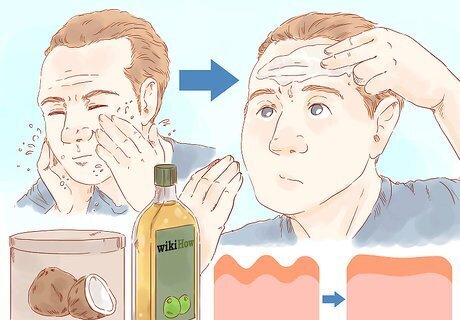
Massage olive oil into your wrinkles. After washing your face in the evening, massage a few drops of slightly warm, extra virgin olive oil directly into the wrinkles and into the area around the wrinkles. This can also be done with a small dab of coconut oil or with a combination of olive oil and coconut oil. Both oils can moisturize the skin and improve its elasticity. The wrinkles should fade as skin elasticity improves.
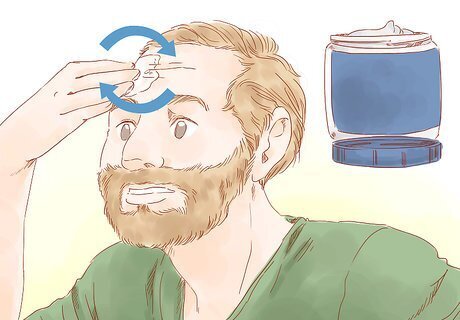
Apply coconut oil to the wrinkled area. Immediately after washing your face in the evening, work a light coating of coconut oil directly into your forehead wrinkles. Continue to massage it into the wrinkles until your skin no longer feels greasy. Dry skin lacks elasticity, and that lack of elasticity can make your wrinkles stand out more. By applying petroleum jelly while your skin is still moist, you can lock in more moisture and keep your skin naturally plumper.

Wear an anti-aging facial patch. "Frownies" and other anti-aging facial patches are stiff adhesive patches that physically hold your skin in place as you sleep. Smooth out your skin and apply the patch directly over your forehead wrinkles immediately before bedtime. Make sure that the entire wrinkle is covered, and keep the patch on for at least three hours or overnight. The muscles in your forehead will be unable to move once you apply the patch. As a result, they won't twist or contort in your sleep, and your wrinkles won't have a chance to deepen further.

Try a citrus face pack. Orange, lemon, and other citrus fruits contain high levels of vitamin C and vitamin E, and both can greatly improve the smoothness and overall health of your skin. You can apply the pulp of most citrus fruits directly to your forehead. Rinse it off with warm water after letting it sit for about 10 minutes. To make another simple face pack, mix 1/4 cup (60 ml) of freshly squeezed orange juice with enough flour to form a creamy paste. Smooth this paste over your forehead and rinse it off with warm water after 20 minutes.
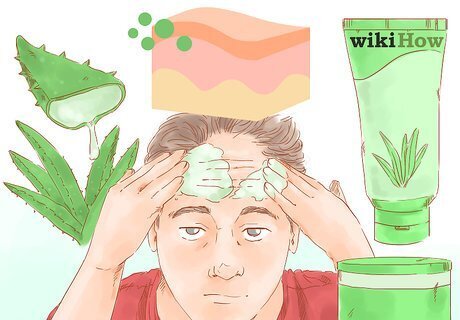
Work aloe vera into the wrinkles. Before washing your face in the morning or evening, massage a dollop of aloe vera gel into the wrinkles of your forehead. Let it remain in place for at least 15 minutes before washing it off with water and a gentle facial cleanser. The acemannan and other polysaccharides in aloe vera can stimulate skin regeneration and healing. As a result, it can soothe dry, damaged skin and may soften the appearance of wrinkles.
Lifestyle Changes

Improve your diet. A healthy, balanced diet can improve your overall health, including the health of your skin. As a general rule, try to eat more fruits and vegetables to increase the number of antioxidants in your body. Antioxidants fight the free radical in your body, leaving you with healthier, younger-looking skin. Salmon and other cold-water fish can also be beneficial since they contain high levels of protein and omega-3 fatty acids. Proteins are among the building blocks of healthy skin and omega-3 keeps skin more thoroughly nourished. Look for wild-caught fish to avoid toxins thought to be present in some farm-raised fish. Consider including more soy in your diet, too. Some studies suggest that soy products can protect and heal skin damage caused by sunlight, including wrinkles. Likewise, cocoa contains the flavanols epicatechin and catechin, both of which improve circulation to skin cells and encourage better hydration. Try to stay clear of refined sugars and refined carbohydrates, as these can cause inflammation that may lead to wrinkles and skin sagging.

Exercise regularly. Regular moderate exercise is an important part of an overall healthy lifestyle, and improving your overall health can increase circulation and skin elasticity throughout your body--including your forehead and the rest of your face. Try taking a 30-minute walk at least once per day, five to seven days per week. Other types of moderate cardiovascular exercise can be equally as beneficial. Include headstands among your usual exercise routine, too. They increase blood flow to your face and scalp, which can improve the health of your skin there. Headstands also force the muscles of the face to relax, thereby lessening wrinkle-producing tension.
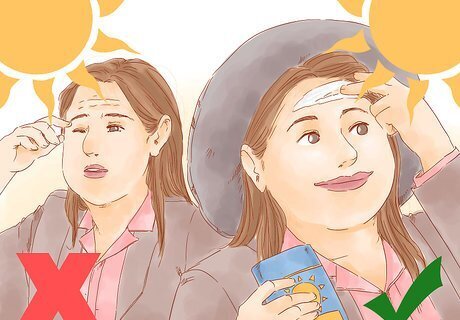
Avoid the sun. Frequent, unprotected exposure to sunlight can worsen your wrinkles by causing your skin to become dry and damaged. Avoid the sun when possible. When you do need to step outside, apply sunscreen to your forehead and over the rest of your body. Consider wearing a hat, as well, to further protect the skin of your face.
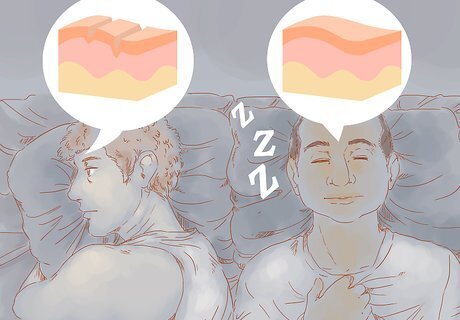
Get enough sleep. Adequate sleep is just as important for your skin as it is for the rest of your body, so try to get seven to eight hours per night. When you lack sleep, the body can produce too much cortisol, and that cortisol gradually breaks down skin cells, causing deeper wrinkles to develop. Additionally, getting more sleep allows your body to produce more human growth hormone (HGH), which can make your skin more elastic and less likely to wrinkle. Try sleeping on your back at night, too. Sleeping on your stomach can cause sleep lines to etch into your brow. Similarly, sleeping on your side can produce wrinkles on your cheeks and chin.
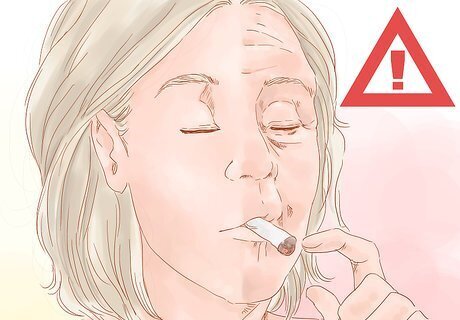
Quit smoking. There are plenty of other reasons to quit the habit if you're currently a smoker, and the reduction of forehead wrinkles is just one more. Cigarette smoke releases an enzyme that breaks down the collagen and elastin in your skin. As these elements break down, your skin loses elasticity, and wrinkles become more prominent.

Stop squinting. If you have a tendency to squint while reading, invest in a pair of reading glasses. When you squint, the muscles in your forehead and around your eyes create a groove beneath the surface of your skin, and this groove can turn into a deep wrinkle. On a related note, you should also wear sunglasses when you step outside. Bright lights tend to make your eyes squint on impulse, and sunglasses can help prevent this from happening.
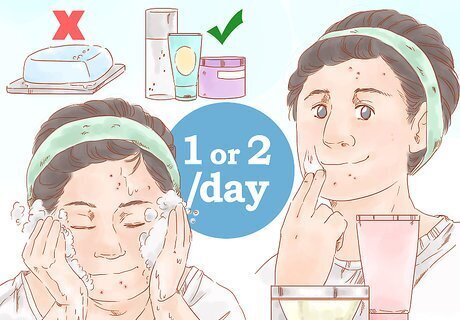
Don't dry out your face. Excessive washing and lack of an effective moisturizer are two of the most drying, damaging things you can do to the skin of your face. Tap water and harsh soaps can strip natural oils and other forms of moisture from your skin. Try to wash your face only once or twice daily and use a gentle facial cleanser when you do. Apply a facial moisturizing cream or lotion to your face immediately after washing it. Doing so locks in more moisture and makes existing wrinkles look less visible.
Professional Treatments
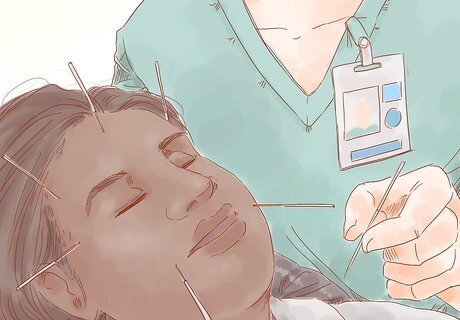
Consider acupuncture. A trained, licensed acupuncturist might be able to reduce your forehead wrinkles by toning the muscles in your face. You'll usually need between 10 to 12 treatments, which will be administered twice a week for five to six weeks. The acupuncturist will insert fine needles into strategic points along the body and face. These needles stimulate the production of collagen and elastin. As a result, your skin naturally plumps up and the circulation to your face improves, which should cause your forehead wrinkles to visibly soften.
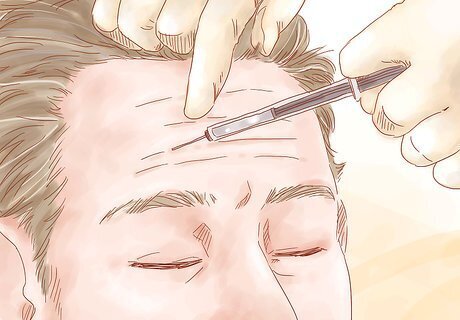
Get neurotoxin injections. Botox and other neurotoxins block the nerve impulses that cause muscle contractions in your forehead. As a result, the wrinkles you currently have look less noticeable and won't get any deeper. Ask for the lowest amount of product they can give and still soften your wrinkles. In the beginning, you may only need 9-15 units to treat your forehead. Aside from Botox, other common neurotoxins include Xeomin and Dysport. Neurotoxin treatments eventually wear off, so you will need another round of injections roughly every 3-4 months if you like the results enough to keep them. EXPERT TIP Alicia Ramos Alicia Ramos Skincare Professional Alicia Ramos is a Licensed Esthetician and the owner of Smoothe Denver in Denver, Colorado. She received her license at the School of Botanical & Medical Aesthetics, with training in lashes, dermaplaning, waxing, microdermabrasion, and chemical peels, and now provides skin care solutions to hundreds of clients. Alicia Ramos Alicia Ramos Skincare Professional Use neurotoxins to minimize movement. Alicia Ramos, a medical aesthetician, says: “To reduce your wrinkles, you really want to do a toxin like Botox or Dysport to minimize movement. Neurotoxins help you avoid wrinkles and help with deep wrinkles, especially on the face and around the eyes.”
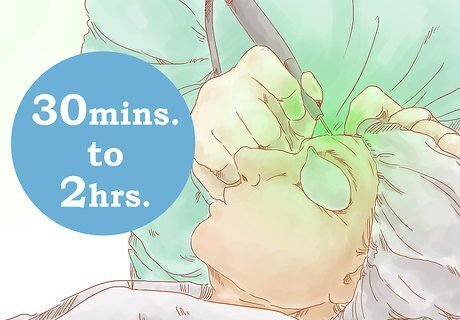
Learn about laser resurfacing. During this treatment, the doctor or technician will direct energy from a laser or pulsed diode light directly to your forehead. The procedure can last anywhere from 30 minutes to two hours. The intense light will remove the top layer of skin, creating a mild wound that usually won't be visible to the naked eye. In response, your skin should activate its natural production of collagen and produce new smooth, wrinkle-free skin.

Ask about chemical treatments. The most common chemical treatments used to treat forehead wrinkles include chemical peels and dermabrasion. During a chemical peel, the doctor will use different chemicals to burn the top layer of skin. Your body should respond to the damage by producing more collagen and, effectively, more smooth skin. During dermabrasion, the doctor will use a mild chemical crystal and a vacuum device to chip away the top layer of skin. This draws evenly textured skin to the surface and should cause light wrinkles and creases to vanish.
Quick Fixes
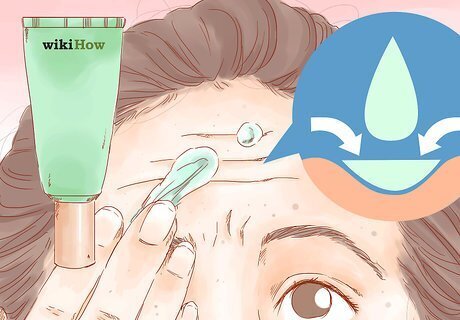
Hide the wrinkles with primer. Apply a thin layer of illuminating face primer after you apply moisturizer and before you apply foundation. Illuminating primers contain small bits of mica, a shiny mineral that can settle into your forehead wrinkles and the other lines of your face. Once there, the bits of mica reflects light away from those wrinkles, thereby reducing their appearance. Additionally, the primer prevents the foundation from settling into your wrinkles and keeping the foundation in place. Since the foundation has a matte finish, it could actually emphasize your wrinkles if it sinks into those lines.
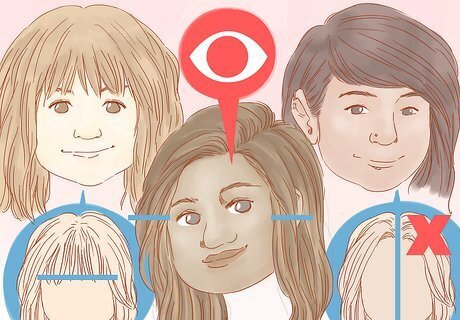
Change your hairstyle. Even though a different hairstyle won't directly affect the appearance of forehead wrinkles, the right style can draw the eye away from your forehead and make them stand out less. Ask your hairstylist to trim your bangs into a soft, choppy fringe that hangs down to your eyebrows. The bangs will cover your forehead wrinkles, hiding them from sight, and can even soften the remaining features of your face. You can also ask your stylist to put highlights into your hair at eye level. The right highlights should brighten the color of your eyes. When your eyes look brighter and more vibrant, your forehead wrinkles will look softer. When doing your hair at home, create a low side part positioned directly above either pupil. Center parts are a bad idea since they frame the forehead and draw unwanted attention to it.



















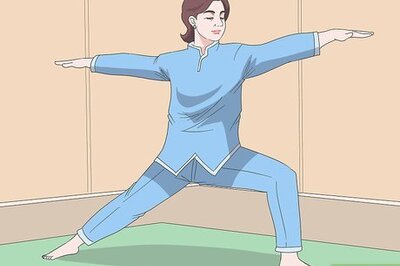
Comments
0 comment